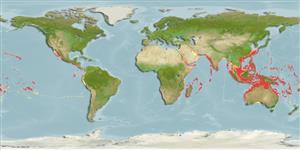Common names from other countries
Teleostei (teleosts) >
Anguilliformes (Eels and morays) >
Ophichthidae (Snake eels) > Ophichthinae
Etymology: Myrichthys: Greek, myros, -ou = male of morey eel + Greek, ichthys = fish (Ref. 45335).
More on author: Cuvier.
Environment: milieu / climate zone / depth range / distribution range
Ecology
Marine; reef-associated; depth range 0 - 262 m (Ref. 9710). Tropical; 30°N - 33°S
Indo-Pacific: Red Sea and East Africa to the central Pacific, not including Hawaii and the Leeward Islands. Replaced by Myrichthys magnificus in the Hawaiian Islands (Ref. 26145, 37816).
Size / Weight / Age
Maturity: Lm ? range ? - ? cm
Max length : 100.0 cm TL male/unsexed; (Ref. 1602); common length : 50.0 cm TL male/unsexed; (Ref. 9137)
Found in sandy areas of reef flats, lagoons, and seaward reefs; living buried in the sand. May aggregate in large numbers under a light at night (Ref. 9710). Sometimes fully exposed when searching for prey (Ref. 30874). Feeds on small fishes and crustaceans (Ref. 89972). Solitary and more common at night (Ref 90102).
Life cycle and mating behavior
Maturities | Reproduction | Spawnings | Egg(s) | Fecundities | Larvae
McCosker, J.E. and R.H. Rosenblatt, 1993. A revision of the snake eel genus Myrichthys (Anguilliformes: Ophichthidae) with the description of a new eastern Pacific species. Proc. Calif. Acad. Sci. 48(8):153-169. (Ref. 40867)
IUCN Red List Status (Ref. 130435)
CITES (Ref. 128078)
Not Evaluated
Threat to humans
Harmless
Human uses
Fisheries: commercial; aquarium: commercial
Tools
Special reports
Download XML
Internet sources
Estimates based on models
Preferred temperature (Ref.
115969): 19.2 - 28.2, mean 26.1 (based on 991 cells).
Phylogenetic diversity index (Ref.
82804): PD
50 = 0.5005 [Uniqueness, from 0.5 = low to 2.0 = high].
Bayesian length-weight: a=0.00089 (0.00039 - 0.00204), b=3.00 (2.80 - 3.20), in cm Total Length, based on LWR estimates for this (Sub)family-body shape (Ref.
93245).
Trophic level (Ref.
69278): 3.6 ±0.5 se; based on size and trophs of closest relatives
Resilience (Ref.
120179): Medium, minimum population doubling time 1.4 - 4.4 years (Preliminary K or Fecundity.).
Fishing Vulnerability (Ref.
59153): High vulnerability (60 of 100).
